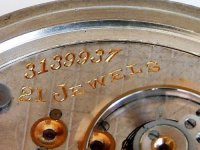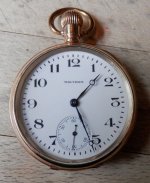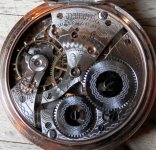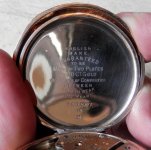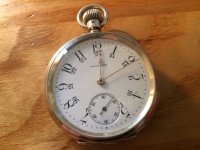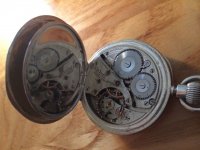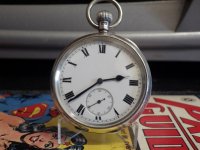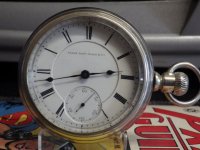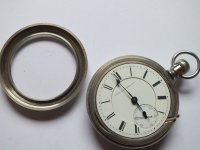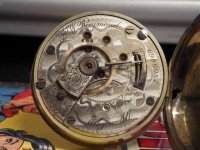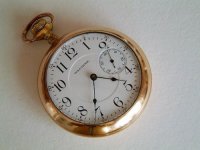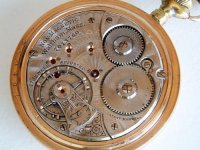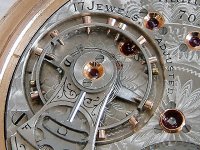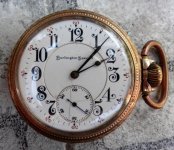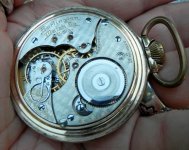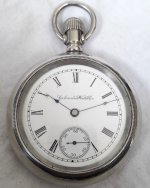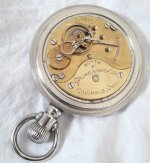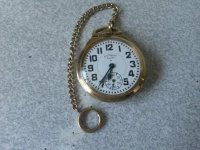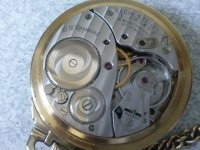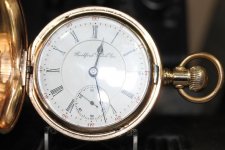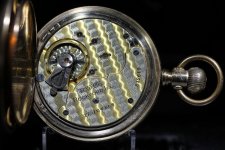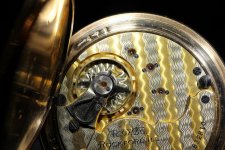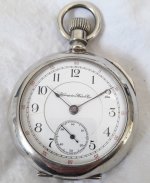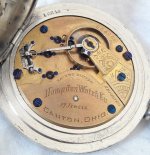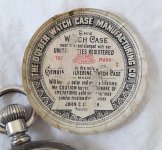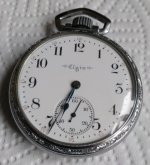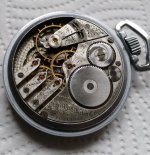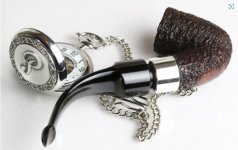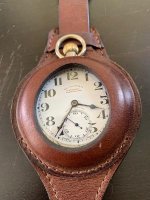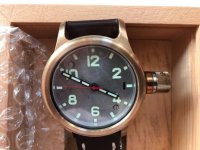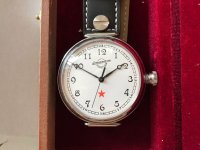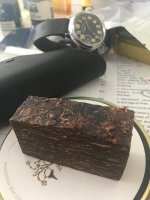Nowadays, Switzerland is rightly considered the home of quality timepieces but in the 19th century and the first half of the 20th century, America was the place to buy quality, accurate watches, particularly pocket watches.
This was mainly due to the railroads and the need for super accurate timekeeping. If you have two trains using the same track and heading towards each other, the driver of one train needs to know precisely when he has to pull into a siding to allow the other train to pass. Sadly this was only fully realised and acted upon after several disastrous collisions that took many lives.
Several ‘railroad standards’ were introduced over the years that set ‘railroad grade’ watches apart from your every day pocket watch. These standards varied from being lever set which involved removing the front bezel and flipping out a tiny lever so the time could then be corrected before setting the lever back & replacing the bezel (this was so as the time of the watch couldn’t accidentally be altered whilst in the pocket), to the watch being placed in an open case (no hunter cases allowed), and the dial furnished with bold Arabic numerals for visual clarity are just some examples that were introduced over the years.
These watches were checked either every week or every fortnight by a railroad watch inspector and records were kept for everyone’s watch. If your watch was out of time you were given a loaner watch until yours had been adjusted (by the railroad company's own watchmaker) to correct timekeeping which was set at +/-30 seconds per week maximum deviation. This equates to just over 4 seconds deviation per day. To put that into perspective, a modern Rolex (costing thousands) is claimed to be accurate within +/- 3 seconds per day.
The later railroad grade watches were finely adjusted in various (maximum 6) positions, such as crown up, crown down, dial up, dial down etc, they were also tested at various levels of temperature as extreme heat or cold will affect a timepiece’s accuracy. All these tests took time & considerable skill to perform. This is why a railroad grade watch was considered a better quality watch and was priced accordingly.
A lot of these pocket watches, both railroad grade and ‘regular’ watches were beautifully decorated on the backs of the movements. Damascening was one method used to beautify these pieces and some watches were decorated to exquisite levels. Incised, engraved and decorated with contrasting metals….such as gold on nickel, some of these have to be seen to be believed, craftsmanship of the highest order. To get that sort of quality decoration nowadays, one would have to have pretty deep pockets! Some even have decoration in places where only a watchmaker will ever see!
Unfortunately many people who have a pocket watch with a choo choo train engraved on the case back assume they have a railroad grade watch, this is not necessarily so, the only way to be sure is to check the unique serial number on the movement and go to one of the many websites that will tell you all you need to know about your watch, model, grade, year of manufacture etc and whether it is a railroad grade or not.
It’s worth pointing out that back in the day, if one wanted to buy a new pocket watch, railroad grade or not, one visited the local jewellery shop & first selected which movement suited both their eye and their budget, then selected the case for that movement (usually based upon cost alone) and the dealer would match the pair right there and then for the buyer.
I have quite a collection of American pocket watches (Swiss & English too), both railroad grade & regular everyman’s watches. Here and on the next page are a few of my favourites.
Hamilton 992 from 1925. Size 16s, 21 jewel R/R grade watch. This watch has a gold centre wheel & gold screw down sapphire jewel settings, a top quality piece that keeps excellent time.
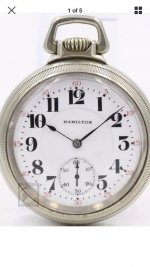
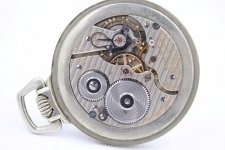
Hamilton 992B from 1967 (my most ‘modern’ piece). Again, size 16s, 21 jewels & R/R grade. It is cased in a Keystone Boss 10K gold filled case and is in mint condition and an excellent timekeeper. One unusual feature of this watch is the dial is made of melamine & not the usual enamel on brass. First picture shows the front bezel removed & the setting lever extended at the 6 minute position.

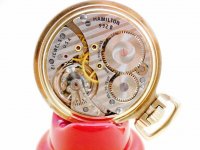
Waltham grade Crescent Street model 1892. This size 18s 19 jewel R/R grade watch from 1904 is a beauty, not least because it has a gold exhibition caseback revealing the beautiful workings of the movement. It has an unusual dial inasmuch as it is a 24 hour dial (often called a Canadian dial) that displays both Roman & Arabic numerals.
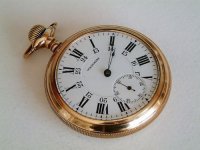
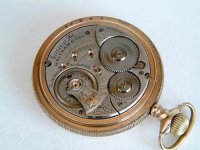
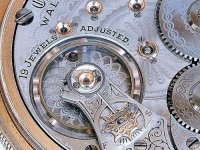
Illinois Watch Co. grade 65 (Army & Navy) made for the 'Washington Watch Co.' Size 18s, 21 jewels in gold settings from 1917. This very heavy watch sits in a nickel case that buffs up super shiny in seconds, another favourite. Very difficult to photograph is the exquisite damascene decoration on the movement with gold highlights which really sparkles in the light. This has the ‘whip’ regulator that I find easiest to adjust. Incidentally the Washington Watch Company was a fictitious name used for watches made by the Illinois Watch Company to be sold exclusively by a company called Montgomery Ward. These were mostly high grade watches.
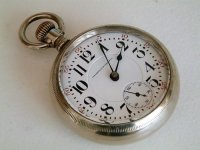
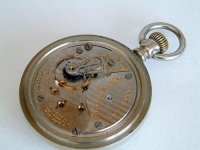
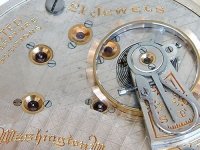
More to follow.
Regards,
Jay.
This was mainly due to the railroads and the need for super accurate timekeeping. If you have two trains using the same track and heading towards each other, the driver of one train needs to know precisely when he has to pull into a siding to allow the other train to pass. Sadly this was only fully realised and acted upon after several disastrous collisions that took many lives.
Several ‘railroad standards’ were introduced over the years that set ‘railroad grade’ watches apart from your every day pocket watch. These standards varied from being lever set which involved removing the front bezel and flipping out a tiny lever so the time could then be corrected before setting the lever back & replacing the bezel (this was so as the time of the watch couldn’t accidentally be altered whilst in the pocket), to the watch being placed in an open case (no hunter cases allowed), and the dial furnished with bold Arabic numerals for visual clarity are just some examples that were introduced over the years.
These watches were checked either every week or every fortnight by a railroad watch inspector and records were kept for everyone’s watch. If your watch was out of time you were given a loaner watch until yours had been adjusted (by the railroad company's own watchmaker) to correct timekeeping which was set at +/-30 seconds per week maximum deviation. This equates to just over 4 seconds deviation per day. To put that into perspective, a modern Rolex (costing thousands) is claimed to be accurate within +/- 3 seconds per day.
The later railroad grade watches were finely adjusted in various (maximum 6) positions, such as crown up, crown down, dial up, dial down etc, they were also tested at various levels of temperature as extreme heat or cold will affect a timepiece’s accuracy. All these tests took time & considerable skill to perform. This is why a railroad grade watch was considered a better quality watch and was priced accordingly.
A lot of these pocket watches, both railroad grade and ‘regular’ watches were beautifully decorated on the backs of the movements. Damascening was one method used to beautify these pieces and some watches were decorated to exquisite levels. Incised, engraved and decorated with contrasting metals….such as gold on nickel, some of these have to be seen to be believed, craftsmanship of the highest order. To get that sort of quality decoration nowadays, one would have to have pretty deep pockets! Some even have decoration in places where only a watchmaker will ever see!
Unfortunately many people who have a pocket watch with a choo choo train engraved on the case back assume they have a railroad grade watch, this is not necessarily so, the only way to be sure is to check the unique serial number on the movement and go to one of the many websites that will tell you all you need to know about your watch, model, grade, year of manufacture etc and whether it is a railroad grade or not.
It’s worth pointing out that back in the day, if one wanted to buy a new pocket watch, railroad grade or not, one visited the local jewellery shop & first selected which movement suited both their eye and their budget, then selected the case for that movement (usually based upon cost alone) and the dealer would match the pair right there and then for the buyer.
I have quite a collection of American pocket watches (Swiss & English too), both railroad grade & regular everyman’s watches. Here and on the next page are a few of my favourites.
Hamilton 992 from 1925. Size 16s, 21 jewel R/R grade watch. This watch has a gold centre wheel & gold screw down sapphire jewel settings, a top quality piece that keeps excellent time.


Hamilton 992B from 1967 (my most ‘modern’ piece). Again, size 16s, 21 jewels & R/R grade. It is cased in a Keystone Boss 10K gold filled case and is in mint condition and an excellent timekeeper. One unusual feature of this watch is the dial is made of melamine & not the usual enamel on brass. First picture shows the front bezel removed & the setting lever extended at the 6 minute position.


Waltham grade Crescent Street model 1892. This size 18s 19 jewel R/R grade watch from 1904 is a beauty, not least because it has a gold exhibition caseback revealing the beautiful workings of the movement. It has an unusual dial inasmuch as it is a 24 hour dial (often called a Canadian dial) that displays both Roman & Arabic numerals.



Illinois Watch Co. grade 65 (Army & Navy) made for the 'Washington Watch Co.' Size 18s, 21 jewels in gold settings from 1917. This very heavy watch sits in a nickel case that buffs up super shiny in seconds, another favourite. Very difficult to photograph is the exquisite damascene decoration on the movement with gold highlights which really sparkles in the light. This has the ‘whip’ regulator that I find easiest to adjust. Incidentally the Washington Watch Company was a fictitious name used for watches made by the Illinois Watch Company to be sold exclusively by a company called Montgomery Ward. These were mostly high grade watches.



More to follow.
Regards,
Jay.








